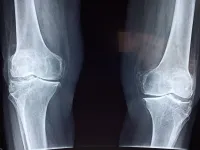INFORMATION:
The study's co-authors are Rebecca Hunt of the Fred Hutchinson Cancer Research Center, Andrea LaCroix of UC San Diego, Dr. John Robbins of UC Davis, Jean Wactawski-Wende of State University of New York, Buffalo, Dr. Karen Johnson of University of Tennessee, Dr. Maryam Sattari of University of Florida, Katie Stone of California Pacific Medical Center Research Institute and San Francisco Coordinating Center, Julie Weitlauf of the Veterans Affairs Palo Alto Health Care System and Stanford University, Dr. Tanya Gure of Ohio State University and Jane Cauley of University of Pittsburgh.
The study was funded by the National Institutes of Health.
One bone fracture increases risk for subsequent breaks in postmenopausal women
2021-05-05
(Press-News.org) Current guidelines for managing osteoporosis specifically call out hip or spine fractures for increasing the risk for subsequent bone breaks. But a new UCLA-led study suggests that fractures in the arm, wrist, leg and other parts of the body should also set off alarm bells.
A fracture, no matter the location, indicates a general tendency to break a bone in the future at a different location, said Dr. Carolyn Crandall, the study's lead author and a professor of medicine at the David Geffen School of Medicine at UCLA.
"Current clinical guidelines have only been emphasizing hip and spine fractures, but our findings challenge that viewpoint," Crandall said. "By not paying attention to which types of fractures increase the risk of future fractures, we are missing the opportunity to identify people at increased risk of future fracture and counsel them regarding risk reduction.
"Postmenopausal women and their physicians may not have been aware that even a knee fracture, for example, is associated with increased risk of future fractures at other locations of the body."
The study will be published May 5 in the peer-reviewed journal EClinicalMedicine.
The researchers examined records from 1993 through 2018 for more than 157,000 women aged 50 through 79. Data was sourced from the Women's Health Initiative, a national study funded by the National Heart, Lung, and Blood Institute.
The researchers found that among postmenopausal women, initial fractures of the lower arm or wrist, upper arm or shoulder, upper leg, knee, lower leg or ankle, and hip or pelvis were associated with an approximately three- to six-fold increase in risk for subsequent fractures. That finding held for all of the age groups studied, with higher risks being more pronounced among non-Hispanic Black, Hispanic or Latina, and Asian Pacific Islander women than among non-Hispanic White women.
The authors noted some limitations to the study, including the fact that the fractures were self-reported by participants. However, earlier research has demonstrated that statistics for self-reported fractures is fairly accurate compared with statistics from medical records.
Also, the researchers did not have information about broken ribs, which may have led them to underestimate the risk for other fractures -- it's possible that the true effect could be even more pronounced than the results show -- and bone mineral density was measured for only a subset of participants, so the researchers could not investigate whether the risk for future fractures was associated with bone density.
Although there is a need for more studies to understand why women of some ethnicities have a greater risk for a subsequent fracture following an initial bone break, the researchers write that their findings "indicate that aggressive follow-up of postmenopausal women who experience initial fracture is indicated. Our results will inform counseling, future guidelines, and the design of intervention trials regarding the selection of appropriate candidates for pharmacotherapy."
ELSE PRESS RELEASES FROM THIS DATE:
New map reveals genes that control the skeleton
2021-05-05
Research led by the Garvan Institute of Medical Research has for the first time mapped the unique genetic profile of the skeleton's 'master regulator' cells, known as osteocytes.
The study published today in Nature Communications outlines the genes that are switched on or off in osteocytes, a type of bone cell that controls how other types of cells make or break down parts of the skeleton to maintain strong and healthy bones.
"This new information provides a kind of genetic shortlist we can look to when diagnosing bone diseases that have a genetic component," says the study's first author Dr Scott Youlten, Research Officer in the Bone Biology ...
Cryptic sense of orientation of bats localised: the sixth sense of mammals lies in the eye
2021-05-05
Mammals see with their eyes, hear with their ears and smell with their nose. But which sense or organ allows them to orient themselves on their migrations, which sometimes go far beyond their local foraging areas and therefore require an extended ability to navigate? Scientific experiments led by the Leibniz Institute for Zoo and Wildlife Research (Leibniz-IZW), published together with Prof. Richard A. Holland (Bangor University, UK) and Dr. Gunārs P?tersons (Latvia University of Life Sciences and Technologies) now show that the cornea of the eyes is the location of such an important sense in migrating bats. If the cornea is anaesthetised, the otherwise ...
New marker predicts benefit of radiotherapy for early-stage breast cancer
2021-05-05
A study involving researchers at Karolinska Institutet and Gothenburg University in Sweden has found that low levels of a protein called PDGFRb are associated with particularly good results of radiotherapy in women with early-stage breast cancer. The study, which is published in the journal Clinical Cancer Research, also suggests that the efficacy of radiotherapy can be improved with drugs that block this protein.
Some 900 women in Sweden are diagnosed with DCIS (ductalcarcinoma in situ), the earliest possible form of invasive breast cancer. Standard treatment is ...
Reduced kidney function linked to increased risk of dementia
2021-05-05
MINNEAPOLIS - Chronic kidney disease is when a person's kidneys progressively lose their ability to filter waste from the blood and eliminate fluids. Now a new study has found that people with reduced kidney function may have an increased risk of developing dementia. The study is published in the May 5, 2021, online issue of Neurology®, the medical journal of the American Academy of Neurology.
Chronic kidney disease affects approximately 15% of adults in the United States and it is more common as people age. However, since many people don't experience ...
Total knee replacement may be more painful for vitamin-D deficient postmenopausal women
2021-05-05
CLEVELAND, Ohio (May 5, 2021)--Vitamin D is a critical part of a healthy diet. Among other benefits, it has been shown to protect against bone disease and maintain soft tissue health. A new study suggests that it may also play a role in the degree of postoperative pain postmenopausal women experience after undergoing total knee replacement. Study results are published online today in Menopause, the journal of The North American Menopause Society (NAMS).
Vitamin D deficiency is a major issue globally. It is estimated that 60% of adults have insufficient levels of the bone-building vitamin. Estrogen deficiency in perimenopausal women has been associated with decreased levels of vitamin D. A sedentary lifestyle and lack of sun exposure have also been shown to contribute to vitamin D ...
Which medications are most toxic to the liver?
2021-05-05
A new study published in the British Journal of Clinical Pharmacology ¬provides insights on how common hospitalized patients develop liver injury from taking different medications.
When investigators analyzed the records of 156,570 hospitalized patients, they found 499 cases of drug-induced liver injury (DILI), for an incidence of 0.32%. Anti-infective agents, cancer medications, and nonsteroidal anti-inflammatory drugs were the major categories of drugs causing DILI, and the highest incidence was due to voriconazole (an antifungal medication). Patients with high cholesterol, cardiovascular disease, ...
Study uncovers potentially avoidable acute care use for vaccine-preventable illnesses in lupus patients
2021-05-05
A new study published in Arthritis Care & Research indicates that few individuals with the autoimmune disease lupus who were publicly insured through Medicaid received recommended vaccines in 2000-2010. Also, those who were unvaccinated needed more acute care for vaccine-preventable illnesses.
From 2000-2010, there were 1,290 patients who visited the emergency department or were hospitalized for vaccine-preventable illness, and 93% of these visits occurred in patients without billing codes for related vaccinations. Patients who were Black had a 22% higher risk of needing such care than those who were white.
"These episodes represent missed opportunities to deliver essential ...
More studies needed on mental health treatments during and after pregnancy
2021-05-05
Untreated mental health disorders can be a serious problem for women and their children during pregnancy and after giving birth, during the postpartum period. A recent analysis funded by the Agency for Healthcare Research and Quality (AHRQ) and published in Psychiatric Research & Clinical Practice notes that few studies have examined the benefits of medications for mental health disorders in pregnant and postpartum women. And while many studies have reported on potential harms, the large majority could not separate the effect of medications from the effect of the underlying disorder. As a result, it ...
Do bacteria in the mouth affect risk of developing rheumatoid arthritis?
2021-05-05
Investigators found similarities in the bacterial composition of the mouth among patients with early rheumatoid arthritis and those at risk of developing the disease, compared with healthy individuals who were not at risk. The findings come from a study published in Arthritis & Rheumatology.
Patients and at-risk individuals had an increased relative abundance of potentially pro- inflammatory bacteria in the mouth, suggesting a possible link between oral microbes and rheumatoid arthritis.
"Prevotella and Veillonella--both gram-negative anaerobes--were at higher relative abundance in saliva, and ...
Erythropoietin treatments may increase hip fracture risk in patients with kidney failure
2021-05-05
Erythropoietin (EPO) is a medication used to stimulate the production of new red blood cells, which is impaired in individuals with kidney failure. Unfortunately, however, the treatment may increase the risk of hip fractures.
In an analysis published in the Journal of Bone and Mineral Research that examined 1997-2013 records from two large U.S. databases, investigators found that EPO doses administered to patients with kidney failure on hemodialysis fluctuated widely over time, and hip fracture rates closely tracked the average dose of EPO doses used in patients.
"Patients with renal failure can benefit from EPO treatment; however, as with all medications, ...


